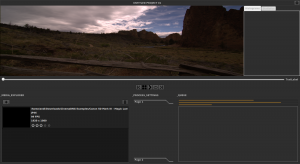Difference between revisions of "OpenCine"
| Line 47: | Line 47: | ||
* Apply color grading nodes to the raw footage (White-balance, Exposure correction, Tonal Curves, etc.) | * Apply color grading nodes to the raw footage (White-balance, Exposure correction, Tonal Curves, etc.) | ||
* Export required clips as *.DPX or *.EXR image sequence (with full bitdepth) for finishing suite | * Export required clips as *.DPX or *.EXR image sequence (with full bitdepth) for finishing suite | ||
| Line 69: | Line 58: | ||
* Read raw bayer pattern data and generate RGB values from 2x2 photosite block which contains 2 green, 1 red and 1 blue value. This automatically reduces the resolution by half in both horizontal and vertical axis. Further resolution reductions could be done by skipping every 2nd, 3rd, etc. 2x2 photosite block. | * Read raw bayer pattern data and generate RGB values from 2x2 photosite block which contains 2 green, 1 red and 1 blue value. This automatically reduces the resolution by half in both horizontal and vertical axis. Further resolution reductions could be done by skipping every 2nd, 3rd, etc. 2x2 photosite block. | ||
=Wishlist= | =Wishlist= | ||
Revision as of 20:27, 15 July 2017
1 Feature Overview
There are several free and open raw-image processing tools for still images like: ufraw, darktable, RawTherapee, Rawstudio, digiKam and many more. While some of them offer batch processing capabilities none of these tools were designed for moving pictures. Processing DNG sequences is cumbersome and time consuming, CinemaDNG MXF files are not yet supported at all. This is where Open Cine should come in. It will be a raw processing tool designed from the ground up for moving images instead of still images.
- Import Footage from Camera over network (FTP Transfer to backup location)
- Import Footage from local drive
- Preview Footage in real-time (GPU based raw debayering at full/reduced resolution [Reduced resolution equates to better playback performance])
- View(all) / Edit(some) Metadata
- Set IN/OUT points in footage
- Apply color relevant RAW transformations (Whitebalance, Exposure, Curves, etc.)
- Save/Load color transformation presets to/from File.
- Adjustments are preserved in a XMP file that stays with the original unaltered footage.
- Compare Color transformations (Presets A,B,C; split screen, etc.) of the same clip or of different clips
- Live Histogram/Vectorscope
- Batch Export RAW footage between IN/OUT to non destructive RAW conforming format (DNG, DPX, etc.)
- Batch Export RAW footage between IN/OUT to destructive digital intermediate format (Quicktime Prores444, AVI DNxHD, Image Sequence, etc.)
- Batch Export RAW footage between IN/OUT to destructive proxy format (Quicktime Prores422 (proxy), Quicktime/AVI MJPEG, etc.)
2 Typical Usage
Reviewing and Sorting Footage
- Import DNG sequence that was shot with a raw camera (Apertus or other) into Open Cine
- View footage in real-time
- mark unneeded clips, rate good clips, write comments for each clip
- later a filter can be used to hide all the bad/unneeded clips. Director could now review only the good ones and continue working with them.
Prepare Footage for Editing
- Import DNG sequence that was shot with a raw camera (Apertus or other) into Open Cine
- Sort through footage and select best clips (rating, marking), shorten to relevant parts in the clips by setting IN/OUT points
- Apply color grading nodes to the raw footage (White-balance, Exposure correction, Tonal Curves, etc.)
- Export Intermediate Clips in FullHD as Avid DNxHD or Apple ProRes for editing in another software
Prepare Footage for Finishing
- An EDL/XML file of a complete edit contains the list of clips we need for finishing, import EDL/XML and link the clips to the raw footage (big win if we find a way to do this automatically)
- Apply color grading nodes to the raw footage (White-balance, Exposure correction, Tonal Curves, etc.)
- Export required clips as *.DPX or *.EXR image sequence (with full bitdepth) for finishing suite
2.1 Real time RAW preview
2 Approaches:
- Read raw bayer pattern data and reduce resolution with pixel skipping (every 2nd, 3rd, 4th, etc. pixels) then do debayering in GLSL shader. We already have the python written Stereocamcheck software that uses GLSL shaders to debayer JP4 RAW in real time. The footage is read via Gstreamer.
- Read raw bayer pattern data and generate RGB values from 2x2 photosite block which contains 2 green, 1 red and 1 blue value. This automatically reduces the resolution by half in both horizontal and vertical axis. Further resolution reductions could be done by skipping every 2nd, 3rd, etc. 2x2 photosite block.
3 Wishlist
The apertus° Lab: http://lab.apertus.org/project/view/19/
4 Screenshots
4.1 Version 0.1 Alpha
5 Developer information
6 Useful links
6.1 Basics
http://wolfcrow.com/blog/the-advantages-of-working-in-32-bit-float/
http://www.is.uni-due.de/fileadmin/literatur/publikation/herwig11spie.pdf
http://users.soe.ucsc.edu/~rcsumner/rawguide/RAWguide.pdf
http://www.siliconimaging.com/DigitalCinema/Files/CameraRawWorkflows.pdf
DNG Test Footage: http://neumannfilms.mediafire.com/?o8ea1dxfrj9fwj9
